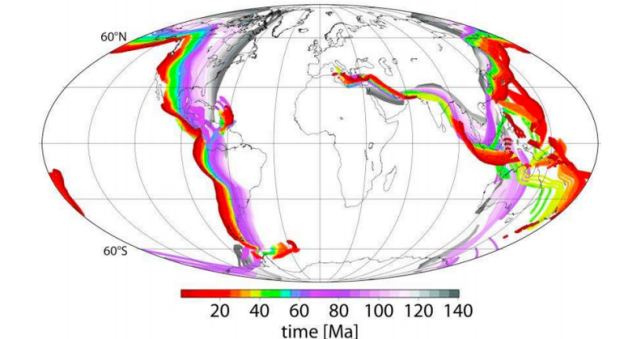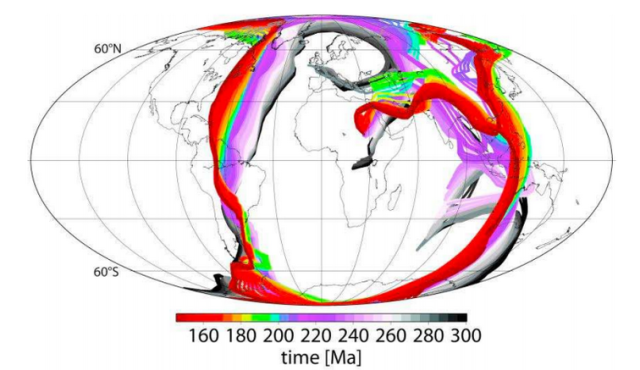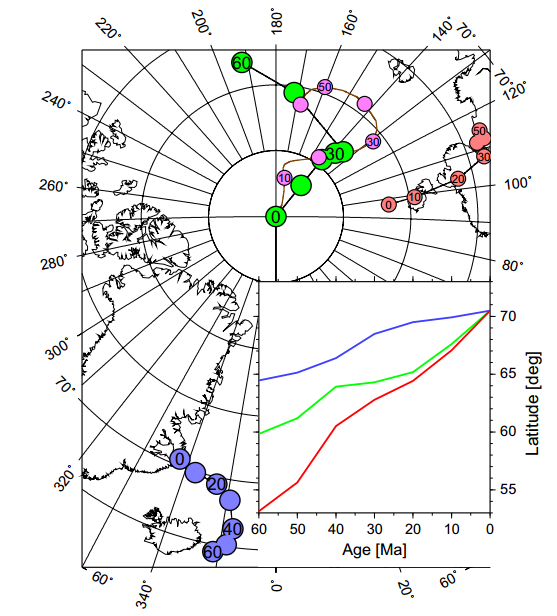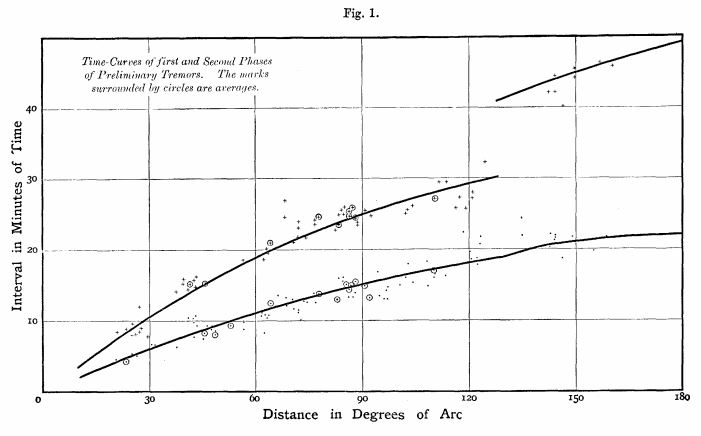In the previous section we described how plate tectonics controls many things on the earth both today and in the past. Here we’ll describe the forces that drive the movements of plates, the patterns of how plates have moved and how computer modelling lets us understand the links between the deep mantle and the surface plates.
The earth is affected by gravitational forces from the sun and the moon. These move huge volumes of water every day, causing the oceanic tides. They even cause small (but measurable) changes to the shape of the earth, the surface moving up and down by a few centimetres. As the earth and moon rotate quickly, these movements are quick and elastic, meaning the earth returns back to its original shape. It’s like a tall building swaying in the wind or during an earthquake. Elastic changes are where atoms move apart from each other, but the bonds within the material are not broken. Plate tectonics is like the entire building is moving, a permanent change caused by rocks slowly flowing or breaking.
Forces caused by plates
There are broadly two sets of forces that move the earth’s plates: those created by the plates themselves and those involving interactions with the mantle below.
Plate tectonics requires plates to be rigid and deform at the edges, they are strong enough that a force acting on one part of the plate pushes the entire plate. There are two sets of forces created at the edge of oceanic plates, one where they are created and another when they destroyed.
diagram of ridge push http://www.columbia.edu/~vjd1/driving_forces_basic.htm>
Ridge push is a force created at mid-ocean ridges where the flowing mantle (asthenosphere) rises up towards the surface. This occurs because the reduction in pressure allows melting and reduces the density of the material. As oceanic lithosphere (oceanic crust plus the stiff mantle material fixed to it) moves away from the ridge it cools and sinks as its density increases. This causes a slope and gravity acting on the higher ridge causes a horizontal force that pushes the entire plate horizontally. Some scientists calculate that a lot of the force pushing India into the Eurasian plate (creating the Himalayas) comes from the many ridges in the Indian ocean pushing on the plate.
Slab pull is a force associated with subducting oceanic lithosphere. Old cold oceanic lithosphere subducts because it’s denser than the surrounding mantle, therefore this negative buoyancy causes a force pulling on the edge of the plate. As it sinks it heats up, but also it is put under increasing pressure from the rock above it. This starts to drive metamorphic reactions that change minerals in the rock into different ones, more stable under the new conditions. Generally minerals with more compact, denser mineral lattices are stable and so the density of the rock is increased. The first transformation is called eclogitisation, but some oceanic plates reach the middle and lower mantle and so will undergo multiple transformations.
We get a sense of the strength of this force by considering how these transformed subducted rocks – eclogites – reach the surface again. Eventually any subduction zone runs out of oceanic lithosphere, and the thin leading edge of the attached continent is pulled into the subduction zone where it is transformed at depth into eclogite. Contintental crust is much more buoyant and thicker than oceanic and resists subduction, meaning that subduction eventually stops. The deeper subducted oceanic lithosphere is pulling the other way and eventually it breaks in two. Once the force of the sinking oceanic lithosphere is removed, the buried edge of the continent, together with a stub of oceanic lithosphere, is quickly pulled back to the surface – bobbing back up like a balloon under-water.
The flowing mantle
Slab pull and ridge push are together one set of forces that act once plates are moving. In addition forces will push onto plates from the convecting mantle below.
Convection is a physical property of bodies that can flow and are hotter below than above. Hotter material is less dense than cool, so rises up and is replaced by cooler sinking material. You can see this sometimes in cooling soup, where patterns of flow affect the surface.
Within the earth, sinking oceanic slabs will drag mantle material down with it and so become the downward flow part of convection. Similarly mid-ocean ridges are places where heat is released from the mantle and may correspond to an upward flow. However evidence from volcanic islands such as Hawaii suggests that mantle flow is more complicated than that. Most earth scientists believe in the existence of mantle plumes, long-lived flows of hotter mantle up towards the surface. The track of a mantle plume across the Pacific explains the pattern of the Hawaiian Islands. A mantle plume that caused volcanic activity in Greenland and the British Isles when the North Atlantic Ocean opened 60 million years ago is still active under Iceland, making that portion of the mid-Atlantic ridge above the surface.
These plumes appear to be unaffected by the passage of plates above them, and some scientists regard them as being fixed in location within the earth, being deep-seated structures.
Seeing the effects of mantle convection on the surface movement of the plates is difficult. There are places on the earth, such as southern Africa which are much higher than we would expect. It seems that this is an area of upward mantle flow and this force is raising up the African continent, forming the high plateau that covers much of South Africa.
Supercontinents
Plate tectonic movements in the past show patterns where continents joined together into supercontinents, only to split apart again. The most famous supercontinent is called Pangea and it existed 270-200 million years ago. It contained all modern continents joined together. It’s breakup led to the creation of the continent shapes we are familiar with today. The Atlantic split apart the Americas from Europe and Africa. India, Antarctica and Australia were split apart by the creation of the Indian ocean. Also the Tethys ocean closed sending India colliding into Eurasia.
Map of Pangea showing modern plate boundaries on it. Like https://www.worldatlas.com/articles/what-is-pangea.html. There are some wonderful examples on http://www.earthdynamics.org/earthhistory/Learn%20About%20Palaeogeography.html
Pangea formed late in the earth’s history. Before it the continents were separated from each other, but by different oceans that are now totally lost (the oceanic plates are now down in the mantle somewhere). We can trace the lines of the lost oceans by the traces of the collision when they formed or by patterns of fossils. Also slices of them called ophiolites may be found, lost within the centre of continents.
The line marking an ancient ocean can be found in countries around the North Atlantic. Called Iapetus, the join where it once was is often close to the modern Atlantic. By painstakingly tracing traces of ancient oceans, combined with computer modelling, scientists have discovered other supercontinents older than Pangea. These are from times so far back that the shapes and names of continents are unfamiliar, but the processes are the same. Up to 13 supercontinents have been identified and named, going right back to earth’s earliest rocks. They appear to form and break-up at intervals of a few hundreds of millions of years.
Whether or not the earth’s continents are all joined together or split into different parts affects many things. Continental shelves are great places for life, creating large areas of shallow water. If all continents are joined together, there is less continental shelf for creatures to live on. Cycles of supercontinent creation and break-up have been linked to changes in climate, patterns of the evolution of life, creation of continental crust, formation of ore deposits and many other things.
Breaking up continents is not easy as continental lithosphere is stable and strong. The break-up of supercontinents seems to be linked to mantle plumes. A plume rising above a continent will heat it and push it up. Mantle flow away from the plume will start pulling the plate apart and the heat and volcanic activity make it easier to break. Some theories suggest that a supercontinent insulates the mantle below and eventually causes a hot plume to rise beneath it. This would explain why supercontinents form and are destroyed again and again in earth history.
Computer modelling goes “beyond plate tectonics”
The only real way to understand the complicated patterns of flow in the earth is by using computer modelling. Only computers than track the different types of force and the fact that this is all happening on a spherical earth. They can be used to try and bring together the theory and the real-life observations to reproduce patterns of plate tectonics over the history of the earth.
In building the models, scientists can use a lot of equations that describe the physics of how hot rocks flow – how they deform and how convection works. They also ensure that all the forces balance, that the earth remains the same size and that the surface plates are not spinning around the world.
Into this theoretical model they add all the observations that led scientists to produce the theory of plate tectonics in the first place. Geological evidence of continental drift shows when continents were joined or moved apart. Magnetic stripes show how ocean basins opened, seismic tomography can see ancient subducted plates and help calculate where subduction zones were in the past. Techniques like palaeomagnetism show what latitudes rocks were at in the past.
Computer models now include all of this information and link it together in a consistent way. These models can describe both the movements of tectonic plates and patterns of ancient mantle plumes. Some say this is moving beyond plate tectonics and into a deeper understanding of how the entire earth works, not just the surface.
One example of the power of these models comes from studies of the distribution of diamonds at the surface of the earth. Diamonds form deep within the mantle, potentially over much of the earth, but they only come to the surface in particular places. Diamonds reach the surface within special types of volcanic eruptions called kimberlites. These are only found in very old parts of continents in Africa, North America, Australia and Asia. Deep under old continents, there is a thick and stable layer of cold and strong mantle attached to the crust. Kimberlites form when this old material is heated and molten rock rich in carbon dioxide is formed. This super-light material quickly shoots to the surface containing fragments of mantle rock within it, sometimes with diamonds. Computer modelling of past plate movements suggested that kimberlite eruptions occur when old continental lithosphere is heated by mantle plumes rising from below. Furthermore, mantle plumes tend to rise from the edges of mysterious structures at the core-mantle boundary called LLSVPs.
<<example of results of this modelling. first diagram in https://www.pnas.org/content/111/24/8735/tab-figures-data
This particular research is fairly recent and like most new studies is not accepted by all scientists. But it illustrates the power of these computer models. If it correctly explains where and when kimberlite eruptions occur, it could help mining companies find new kimberlites and so find new diamond mines.
These computer models are never complete. Scientists using computer modelling of complex systems like climate or the earth’s interior joke that all models are wrong, but the best ones are useful. They understand that new research will improve on existing models, but ones today can increase our understanding and suggest new areas of research.
First publication by Xiaoduo Media in Front Vision. Front Vision is a Chinese online science magazine for children. My original English text produced with permission.








